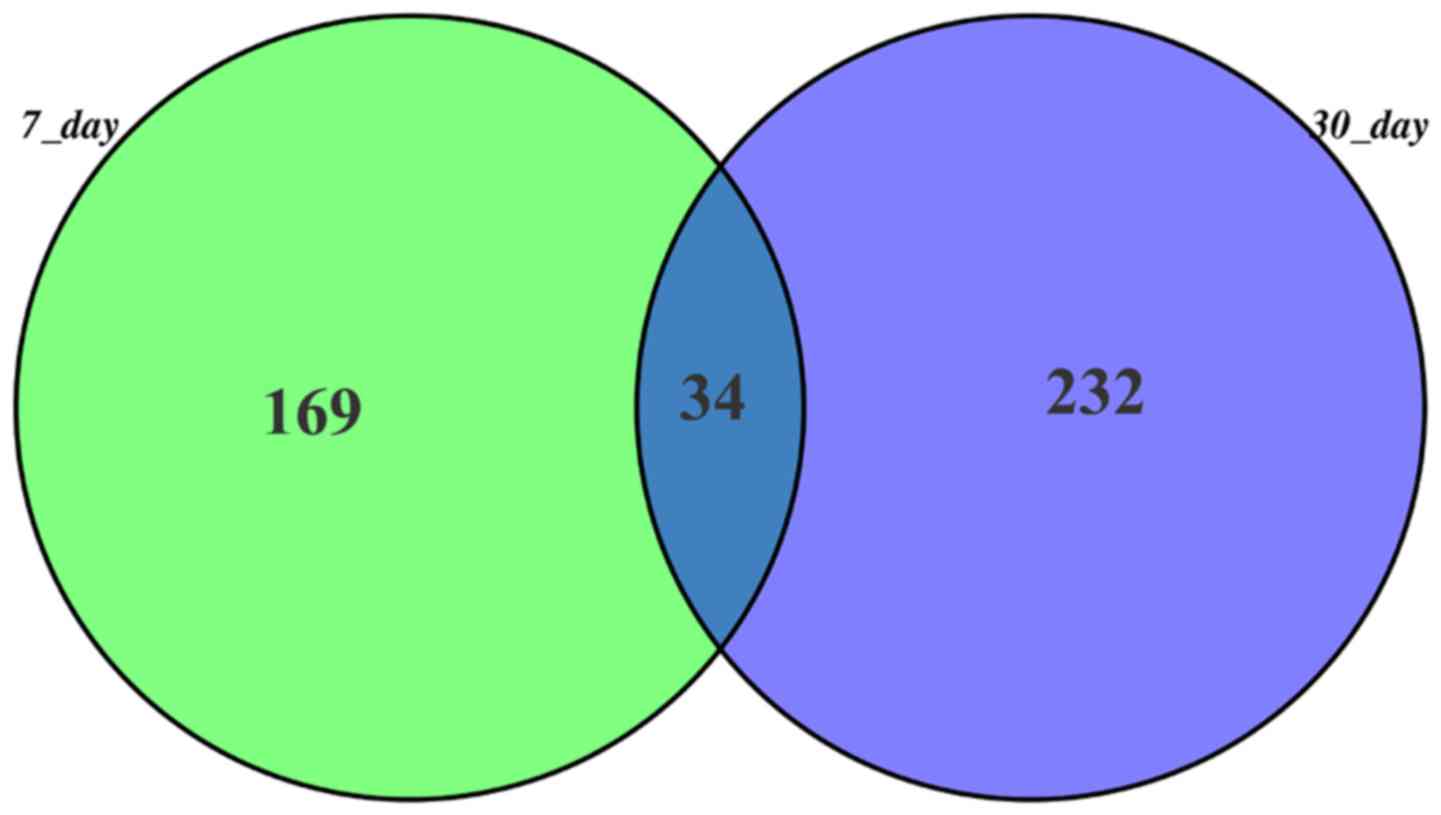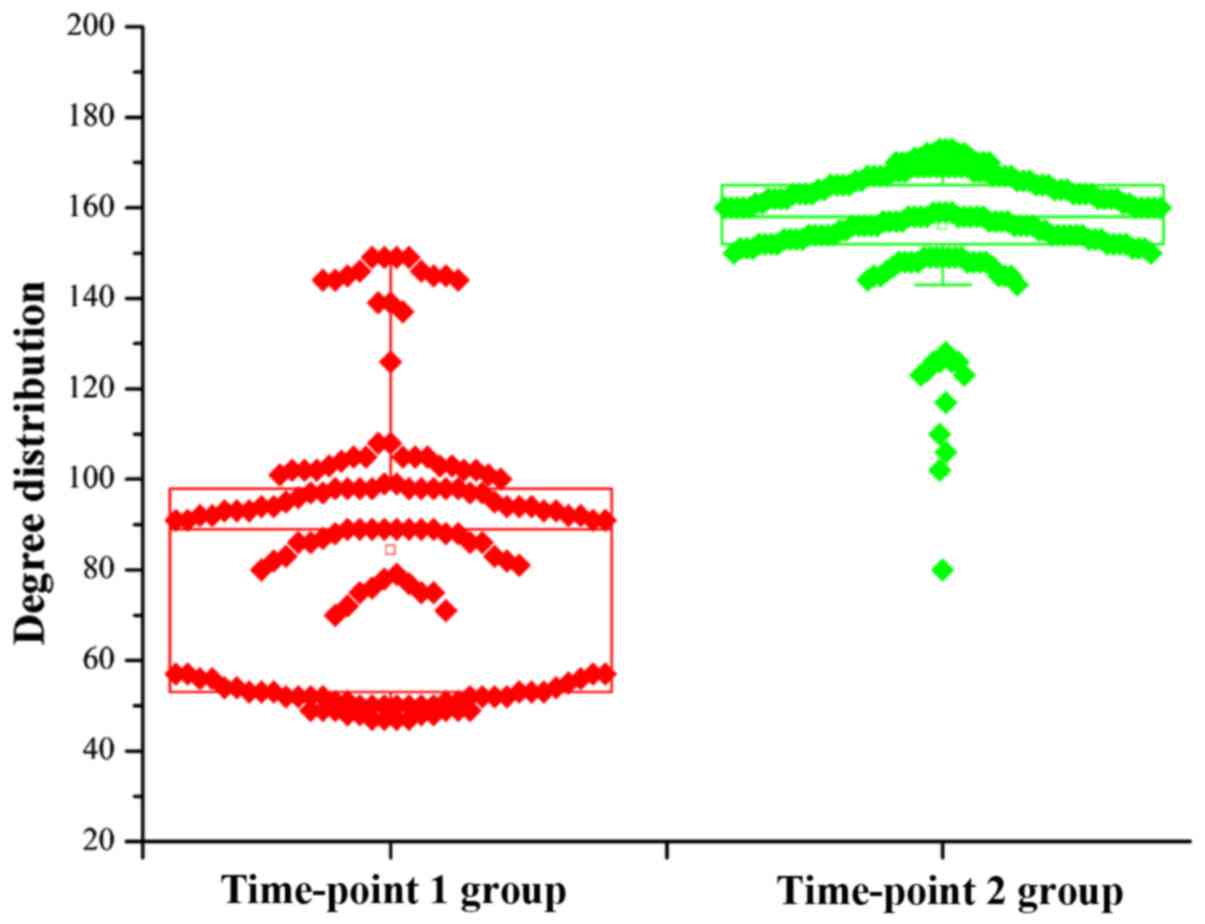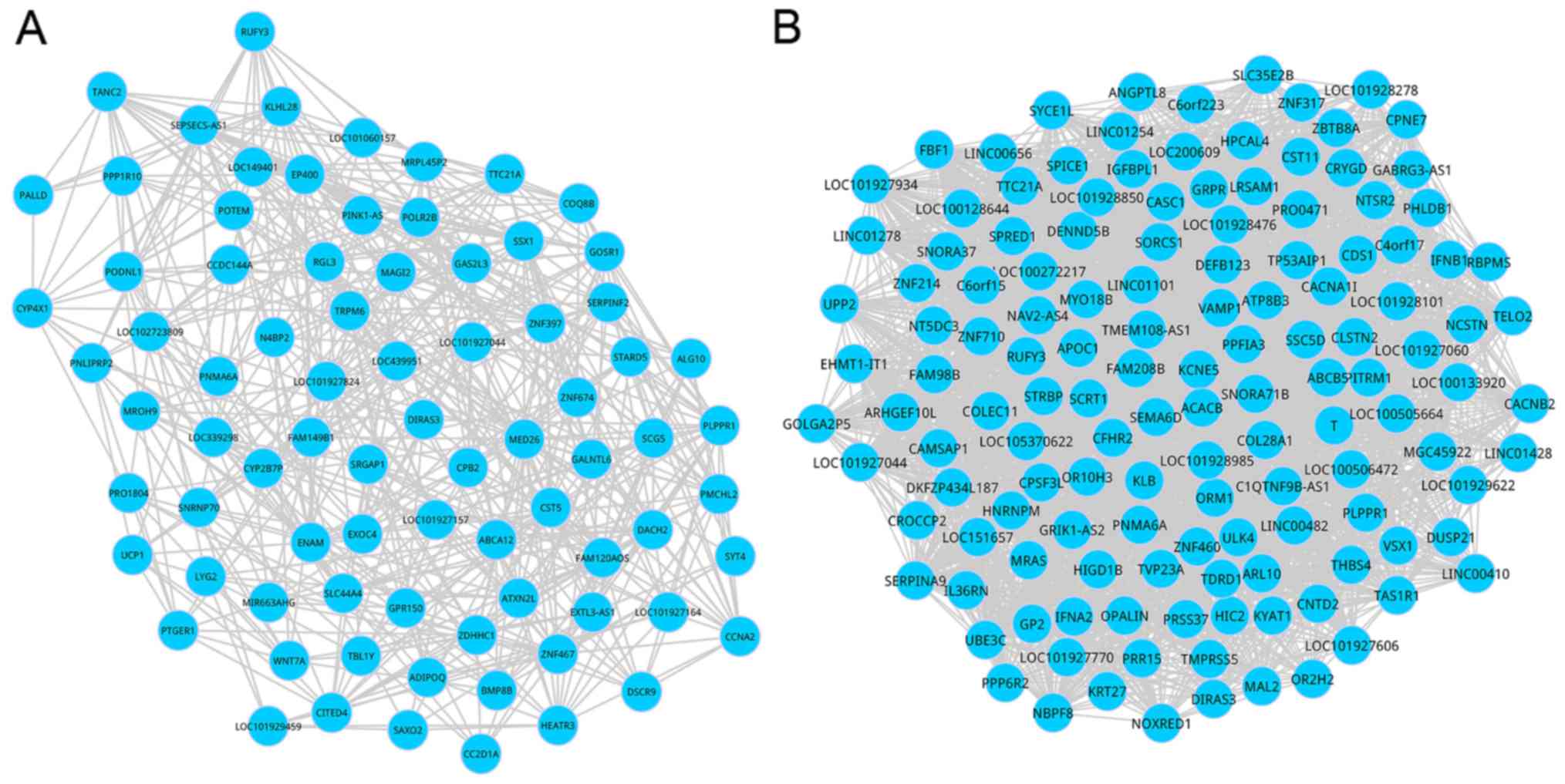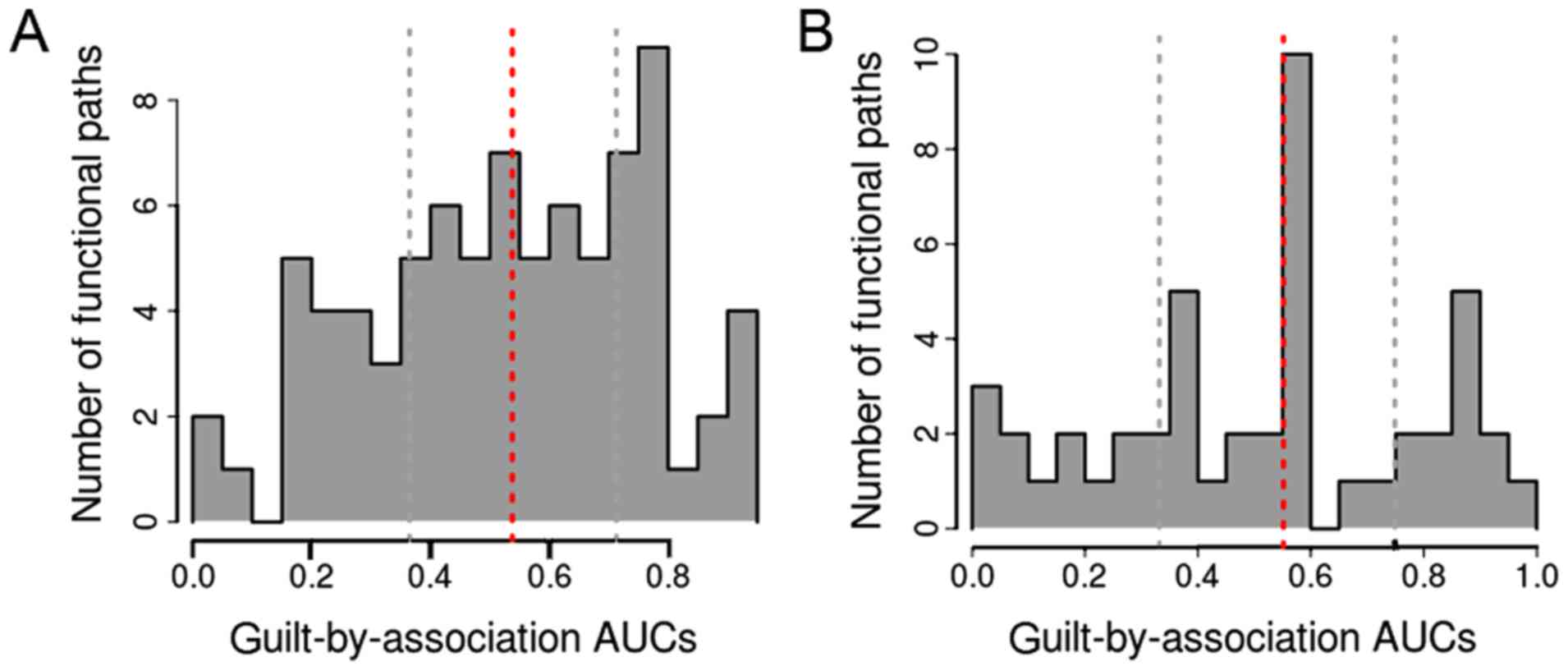Constructing differential co‑expression network to predict key pathways for myocardial infarction
- Authors:
- Published online on: February 26, 2019 https://doi.org/10.3892/etm.2019.7321
- Pages: 3029-3034
-
Copyright: © Guo et al. This is an open access article distributed under the terms of Creative Commons Attribution License.
Abstract
Introduction
Cardiovascular disease (CVD) causes ~17.3 million deaths per year globally and remains the main cause of mortality in the world (1). Acute coronary syndromes (ACSs) range from unstable angina (UA) to myocardial infarction (MI). UA is a common clinical symptom of atherosclerosis without myocardial necrosis, is related to the increased risk of cardiac death, and leads to MI (2). However, the diagnostic accuracy for UA is unsatisfactory in clinical practice. The mortality of MI in the USA has decreased, partly because of the earlier diagnosis and the reliable revascularization therapy (3). For instance, troponin, a biomarker of myocardial damage, maximizes the benefits of revascularization therapy. Nevertheless, because of the relative ‘delayed’ release time of troponin, earlier biochemical signatures having high sensitivity as well as specificity are urgently needed to reduce the MI mortality (4). Thus, new thoughts are warranted to develop efficient diagnosis and optimal therapeutics for UA/MI.
Traditionally, one method is the identification of differentially expressed genes (DEGs). However, this approach only offers limited information on the progression of the disease. There is little concordance among different microarray studies, due to the heterogeneity of the tissue samples or insufficient power (5). Significantly, a gene can be connected to other genes which share similar expression profiles. Systems biology concentrates on complicated interactions in biological systems by means of a holistic approach to biological research (6,7). Network biology, a branch of the systems biology, is a new way of analyzing biological processing, which regards life as a network. Differential co-expression network (DCN) has been demonstrated to be a new holistic approach for analyzing microarrays (8,9). For instance, Stuart et al (10) established a gene co-expression network which linked to genes whose microarray data were similar among different organisms. Lee et al (8) analyzed a human network based on functional grouping as well as cluster analysis.
Importantly, pathway-based analysis plays key roles in capturing the biological interaction among genes, and improving power and robustness (11,12). Thus, exploring the biological pathways relying on systems biology techniques can provide extensive insights into the components of pathways, thereby aiding in developing novel targets for diseases. However, previous studies have mainly focused on the single dysregulated pathways based on the pre-defined threshold (13,14). Pathways having significant P-values did not have biological meaning, but several pathways possessing non-significant P-values are statistically significant and biological meaningful (15). Based on the variants of ‘guilt-by-association (GBA)’, gene pathway predictions can be made with very high statistical confidence (16,17).
Thus, in our analysis, we downloaded the gene expression profile of the blood samples of patients with MI or UA to identify the optimal pathways which can provide comprehensive information for UA/MI development. DEGs between UA and MI were extracted using LIMMA package, and pathway enrichment analysis was conducted for the DEGs, based on the DAVID tool, to detect the significant pathways. Then, DCN and sub-DCN for the DEGs were constructed. KEGG pathways were extracted based on the known pathway database and DEGs. Subsequently, we predicted informative pathways using the GBA principle, relying on the area under the curve (AUC), and the pathway categories with AUC>0.8 were defined as the informative pathways. Finally, we selected the optimal pathways based on the traditional pathway analysis and sub-DCN-based-GBA pathway prediction method.
Materials and methods
Gene expression profile and data pretreatment
Gene expression profiles of the whole blood of 26 patients with ACS, obtained at 7 and 30 days post-ACS, were downloaded from Gene Expression Omnibus (GEO): GSE29111 (https://www.ncbi.nlm.nih.gov/geo/query/acc.cgi?acc=GSE29111). GSE29111 dataset includes the data of 8 patients with UA and 18 with MI. The samples in GSE29111 were taken at two different time-points: time-point 1 (7th day) and time-point 2 (30th day).
Before the analysis, the microarray profiles of GSE29111 data were first processed on the GPL570 platform of Affymetrix Human Genome U133 Plus 2.0 Array (Affymetrix; Thermo Fisher Scientific, Inc., Waltham, MA, USA).
Next, the data were normalized based on the Robust Multi-array Average (RMA) method (18), and then the data in the CEL files were converted into expression values. Probes were aligned to human genes, and finally, 20,514 genes remained for subsequent investigation.
Detection of DEGs
In our study, LIMMA package of R language (http://bioconductor.org/biocLite.R) as well as t-test were utilized to compare the gene expression levels in time-point 1 and time-point 2 groups in order to further identify the DEGs in MI samples comparing with UAs. logFC was used for the differential expression degree. We processed the original data based on log2 transformation using SPSS 17.0 (SPSS, Inc., Chicago, IL, USA). All expression scores were turned into fold-changes (FC) with log2 base (logFC). The logFC for each gene was defined as log(MI)-log(UA), and then the distribution of the logFC value for each gene was obtained. The original P-values were adjusted using the method of Benjamini et al (19), which relies on the false discovery rate (FDR) concept. Genes were considered statistically significantly expressed when FDR<0.01 and |logFC| >1.
Pathway analysis of DEGs using DAVID
To investigate the potential biological functions of DEGs, we used DAVID (http://david.abcc.ncifcrf.gov/) (20) to implement the traditional pathway analysis based on KEGG pathway database (https://www.kegg.jp/) by means of the Expression Analysis Systematic Explorer (EASE) test (21). The threshold of identifying significant pathways was FDR=0.001.
Construction of DCN
The co-expression network approach, proposed by Ruan et al (22), was utilized to construct DCN by investigating the pairwise expression similarity between DEGs. The co-expression network with 0 refers to no link between two DEGs, and 1 corresponds to a connection between the DEGs. Nodes in the DCN are genes and the edges stand for expression similarities between any two genes. In our study, Spearman correlation coefficient (SCC) was used to measure the similarity, and to assess the co-expressed strength of each edge in the DCN. We defined the SCC absolute value of an edge as the weight of the corresponding interaction. If the correlation coefficient of the two DEGs is >0.3, these two DEGs are regarded to be co-expressed. In the present study, we only selected the edges with weight value >0.8 to construct the sub-DCN, which was visualized using Cytoscape tool (https://www.softpedia.com/get/Science-CAD/Cytoscape.shtml).
KEGG annotation for DEGs
KEGG is a reference knowledge database which can provide better understanding of the biological processes. To begin with, we downloaded a total of 300 background pathways (6,919 genes) from KEGG database. Next, the above identified DEGs were mapped to 300 pathway terms to extract the DEG-related pathways. In the end, the pathway set was obtained in time-point 1 and time-point 2 groups, consisting of 203 DEGs and 81 pathways in time-point 1 group, and 266 DEGs as well as 47 pathways in time-point 2 group.
Informative pathways prediction using the GBA principle
Subsequently, we used GBA principle for the sub-DCN to further extract significant biological pathways in these two time-point groups. For each gene within the sub-DCN, all neighbored genes of this specific gene were aligned to each pathway category, and the multifunctionality (MF) value for each gene involved in the given pathway term was computed.
The AUC value for each pathway category was measured using the Support Vector Machine (SVM), and then the mean AUC across all pathway terms was obtained. Afterwards, we ranked all the pathway terms based on the AUC values. In literature, AUC>0.7 is good for gene function prediction (23). In the present study, we predicted the informative pathway terms when AUC was set as >0.8.
Identifying the optimal pathways
The final optimal pathways were identified based on the traditional pathway analysis and sub-DCN-based-GBA pathway prediction method.
Results
Time-point 2 group influences more DEGs compared to time-point 1 group
Our analyses were focused on the comparison of two matched sets of blood samples (UA vs. MI) obtained at two different time-points. Therefore, a total of 20,514 genes remained to be used for the following comparisons after quality control.
Based on the filtering criteria of FDR<0.01 and |logFC| >1, there were 203 and 266 DEGs in the expression profile of blood of MI samples comparing with UAs in time-point 1 and time-point 2 groups, respectively. Also, there were 34 common genes in these two groups (Fig. 1).
Pathway enrichment analysis of DEGs using DAVID
When FDR was set as <0.001, a total of 6 significant pathways were identified in the time-point 1 group, and there were 8 significant pathways in the time-point 2 group. The differential pathways in the two groups are shown in Table I. We found that there were 3 common significant pathways in these two time groups, including neuroactive ligand-receptor interaction, cytokine-cytokine receptor interaction, and MAPK signaling pathway.
Construction of DCN and sub-DCN
Two DCNs were established for time-point 1 and time-point 2 groups by means of the DEGs identified above. In the DCN of time-point 1 group, there were 153 nodes, and in the DCN of the time-point 2 group there were 197 nodes. In the circumstance of network, the degree can explain the network structure. Consequently, the topological degree characteristics for each node in the DCN was investigated, and the degree distribution of all genes is shown in Fig. 2. It is obvious that the degrees for the DCN in the time-point 2 group were greater than those in the time-point 1 group. Aside from the degree connectivity, another significant parameter was the interaction strength which could be used to measure the interactions in the DCN. Consequently, SCC was utilized to assign a weight value to every edge of the DCN, and the interactions having weight values >0.8 were extracted to build the sub-DCN. The composition of the sub-DCNs is demonstrated in Fig. 3. Within the sub-DCNs, 80 nodes and 705 interactions were involved in the time-group 1, and there were 135 nodes and 2,836 interactions in the time-group 2.
Informative pathways using GBA prediction
Fig. 4 shows the AUC distribution for the pathway categories. There were 23 and 13 pathway terms in the time-point 1 and time-point 2 groups, respectively, based on AUC>0.7. Among these pathway terms, there were 7 and 10 pathway terms, respectively, with AUC>0.8, and these pathways were determined as the informative pathways (Table II).
Identifying the optimal pathways
The ultimate optimal pathways were screened out based on the traditional pathway analysis and sub-DCN-based-GBA pathway prediction method. A total of 2 optimal pathways were identified in the time-point 1 group, including cytokine-cytokine receptor interaction, and MAPK signaling pathway. Also, there were 3 optimal pathways in the time-point 2 group, including MAPK signaling pathway, calcium signaling pathway, and cytokine-cytokine receptor interaction. Based on these results, we found that cytokine-cytokine receptor interaction, as well as MAPK signaling pathway were the common optimal ones in these two groups. Calcium signaling pathway was unique to the whole blood of patients with ACS obtained at 30 days post-ACS.
Discussion
In the present study, microarray data of whole blood samples from ACS patients were analyzed using the integrated strategy. A total of 203 and 266 DEGs were identified from the expression profile of blood of MI samples comparing with UAs in the time-point 1 and time-point 2 groups. Moreover, 7 and 10 informative pathway terms, respectively, were identified based on AUC>0.8. Finally, cytokine-cytokine receptor interaction, as well as MAPK signaling pathway were the common optimal pathways in these two groups. Calcium signaling pathway was unique to the whole blood of patients with ACS taken at 30 days post-ACS, and none was unique to the whole blood of patients with ACS obtained at 7 days post-ACS.
The pathway of MAPK signaling was common in the two groups, which is associated with immune responses. The functions of inflammation in ACS patients have been implicated previously (24). Inflammation is able to cause biochemical responses (25) and then trigger MAPK, which plays important roles through phosphorylating intracellular substrates, thereby mediating signal transduction, as well as specific genetic responses to extracellular stimuli (26). MAPK activation in UA to a complete MAPK activation in MI, has been proved effective as a diagnostic test to discern the difference between ACS conditions (27). Accordingly, MAPK is a valuable molecular biomarker serving as specific signature for the diagnosis of UA/MI.
The pathway of cytokine-cytokine receptor interaction was common in the two groups of our study. Cytokines are extracellular molecules that transmit intercellular signals, and they are broadly reported in cell differentiation, as well as inflammatory response through binding to specific receptors on the cell surface (28). Various cytokines associated with inflammation, for example, tumor necrosis factor, interleukin-8, adhesion molecules, and nuclear factor-κB play crucial roles in the development process of ACS (29). Elevated level of interleukin-8 has been demonstrated to be linked to an increased risk of coronary artery disease (30). Accordingly, the role of the pathway of cytokine-cytokine receptor interaction is confirmed in the progression of ACS, partially through regulating inflammatory response.
Interestingly, calcium signaling pathway appeared in the whole blood of patients with ACS collected at 30 days post-ACS. Calcium, a universal intracellular second messenger, participates in regulating diverse functions including fertilization, secretion, gene transcription, and cardiac myocytes. Several studies have implicated that calcium rises during MI (31,32). Nevertheless, decreased cell coupling would result in arrhythmias (33). Garcia-Dorado et al (34) have demonstrated that developing available and reliable treatments to restrain Ca2+-mediated cardiomyocyte death in patients with MI, through regulating the Ca2+ influx, or intracellular Ca2+ handling, is an important therapeutic implication. Demonstrated here, our result suggests that calcium signaling pathway is related to the development of ACS.
There were several limitations in this study. Limited number of samples might lead to biased estimates. In addition, only a bioinformatics strategy was utilized, and yet we have not proven our conclusions using any lab experiments. Despite these shortcomings, our analysis could provide key implications for the molecular mechanisms of ACS, but further research is necessary to validate our findings on the basis of lab techniques.
In conclusion, the identified optimal pathways might be important for revealing the development progress of ACS. Further research is needed to explore the underlying mechanisms for the ACS progression using animal models.
Acknowledgements
Not applicable.
Funding
No funding was received.
Availability of data and materials
The datasets used and/or analyzed during the present study are available from the corresponding author on reasonable request.
Authors' contributions
SZG drafted the manuscript and analyzed the data; WJL conceived the study and revised the manuscript. Both authors read and approved the final manuscript.
Ethics approval and consent to participate
Not applicable.
Patient consent for publication
Not applicable.
Competing interests
The authors declare that they have no competing interests.
References
|
Mozaffarian D, Benjamin EJ, Go AS, Arnett DK, Blaha MJ, Cushman M, de Ferranti SD, Després JP, Fullerton HJ, Howard VJ, et al American Heart Association Statistics Committee and Stroke Statistics Subcommittee, : Heart disease and stroke statistics – 2015 update: A report from the American Heart Association. Circulation. 131:e29–322. 2015. View Article : Google Scholar : PubMed/NCBI | |
|
Wright RS, Anderson JL, Adams CD, Bridges CR, Casey DE Jr, Ettinger SM, Fesmire FM, Ganiats TG, Jneid H, Lincoff AM, et al: 2011 ACCF/AHA focused update of the Guidelines for the Management of Patients with Unstable Angina/Non-ST-Elevation Myocardial Infarction (updating the 2007 guideline): A report of the American College of Cardiology Foundation/American Heart Association Task Force on Practice Guidelines developed in collaboration with the American College of Emergency Physicians, Society for Cardiovascular Angiography and Interventions, and Society of Thoracic Surgeons. J Am Coll Cardiol. 57:1920–1959. 2011. View Article : Google Scholar : PubMed/NCBI | |
|
Yeh RW, Sidney S, Chandra M, Sorel M, Selby JV and Go AS: Population trends in the incidence and outcomes of acute myocardial infarction. N Engl J Med. 362:2155–2165. 2010. View Article : Google Scholar : PubMed/NCBI | |
|
Van de Werf F, Ardissino D, Betriu A, Cokkinos DV, Falk E, Fox KA, Julian D, Lengyel M, Neumann FJ, Ruzyllo W, et al Task Force on the Management of Acute Myocardial Infarction of the European Society of Cardiology, : Management of acute myocardial infarction in patients presenting with ST-segment elevation. The Task Force on the Management of Acute Myocardial Infarction of the European Society of Cardiology. Eur Heart J. 24:28–66. 2003. View Article : Google Scholar : PubMed/NCBI | |
|
Louwen F, Muschol-Steinmetz C, Reinhard J, Reitter A and Yuan J: A lesson for cancer research: Placental microarray gene analysis in preeclampsia. Oncotarget. 3:759–773. 2012. View Article : Google Scholar : PubMed/NCBI | |
|
Wang B, Huang DS and Jiang C: A new strategy for protein interface identification using manifold learning method. IEEE Trans Nanobioscience. 13:118–123. 2014. View Article : Google Scholar : PubMed/NCBI | |
|
Xia JF, Zhao XM, Song J and Huang DS: APIS: Accurate prediction of hot spots in protein interfaces by combining protrusion index with solvent accessibility. BMC Bioinformatics. 11:1742010. View Article : Google Scholar : PubMed/NCBI | |
|
Lee HK, Hsu AK, Sajdak J, Qin J and Pavlidis P: Coexpression analysis of human genes across many microarray data sets. Genome Res. 14:1085–1094. 2004. View Article : Google Scholar : PubMed/NCBI | |
|
van Noort V, Snel B and Huynen MA: The yeast coexpression network has a small-world, scale-free architecture and can be explained by a simple model. EMBO Rep. 5:280–284. 2004. View Article : Google Scholar : PubMed/NCBI | |
|
Stuart JM, Segal E, Koller D and Kim SK: A gene-coexpression network for global discovery of conserved genetic modules. Science. 302:249–255. 2003. View Article : Google Scholar : PubMed/NCBI | |
|
Tilford CA and Siemers NO: Gene set enrichment analysis. Methods Mol Biol. 563:99–121. 2009. View Article : Google Scholar : PubMed/NCBI | |
|
Curtis RK, Oresic M and Vidal-Puig A: Pathways to the analysis of microarray data. Trends Biotechnol. 23:429–435. 2005. View Article : Google Scholar : PubMed/NCBI | |
|
Zhang T, Zhao LL, Zhang ZR, Fu PD, Su ZD, Qi LC, Li XQ and Dong YM: Interaction network analysis revealed biomarkers in myocardial infarction. Mol Biol Rep. 41:4997–5003. 2014. View Article : Google Scholar : PubMed/NCBI | |
|
Bu X, Wang B, Wang Y, Wang Z, Gong C, Qi F and Zhang C: Pathway-related modules involved in the application of sevoflurane or propofol in off-pump coronary artery bypass graft surgery. Exp Ther Med. 14:97–106. 2017. View Article : Google Scholar : PubMed/NCBI | |
|
Donato M, Xu Z, Tomoiaga A, Granneman JG, Mackenzie RG, Bao R, Than NG, Westfall PH, Romero R and Draghici S: Analysis and correction of crosstalk effects in pathway analysis. Genome Res. 23:1885–1893. 2013. View Article : Google Scholar : PubMed/NCBI | |
|
Sharan R, Ulitsky I and Shamir R: Network-based prediction of protein function. Mol Syst Biol. 3:88. 2007. View Article : Google Scholar : PubMed/NCBI | |
|
Zuberi K, Franz M, Rodriguez H, Montojo J, Lopes CT, Bader GD and Morris Q: GeneMANIA prediction server 2013 update. Nucleic Acids Res. 41:W115–W122. 2013. View Article : Google Scholar : PubMed/NCBI | |
|
Gautier L, Cope L, Bolstad BM and Irizarry RA: affy - analysis of Affymetrix GeneChip data at the probe level. Bioinformatics. 20:307–315. 2004. View Article : Google Scholar : PubMed/NCBI | |
|
Benjamini Y, Drai D, Elmer G, Kafkafi N and Golani I: Controlling the false discovery rate in behavior genetics research. Behav Brain Res. 125:279–284. 2001. View Article : Google Scholar : PubMed/NCBI | |
|
Huang W, Sherman BT and Lempicki RA: Systematic and integrative analysis of large gene lists using DAVID bioinformatics resources. Nat Protoc. 4:44–57. 2009. View Article : Google Scholar : PubMed/NCBI | |
|
Ford G, Xu Z, Gates A, Jiang J and Ford BD: Expression Analysis Systematic Explorer (EASE) analysis reveals differential gene expression in permanent and transient focal stroke rat models. Brain Res. 1071:226–236. 2006. View Article : Google Scholar : PubMed/NCBI | |
|
Ruan J, Dean AK and Zhang W: A general co-expression network- based approach to gene expression analysis: Comparison and applications. BMC Syst Biol. 4:82010. View Article : Google Scholar : PubMed/NCBI | |
|
Gillis J and Pavlidis P: The role of indirect connections in gene networks in predicting function. Bioinformatics. 27:1860–1866. 2011. View Article : Google Scholar : PubMed/NCBI | |
|
Mulvihill NT, Foley JB, Murphy R, Crean P and Walsh M: Evidence of prolonged inflammation in unstable angina and non-Q wave myocardial infarction. J Am Coll Cardiol. 36:1210–1216. 2000. View Article : Google Scholar : PubMed/NCBI | |
|
Wang Y: Mitogen-activated protein kinases in heart development and diseases. Circulation. 116:1413–1423. 2007. View Article : Google Scholar : PubMed/NCBI | |
|
Indolfi C, Avvedimento EV, Di Lorenzo E, Esposito G, Rapacciuolo A, Giuliano P, Grieco D, Cavuto L, Stingone AM, Ciullo I, et al: Activation of cAMP-PKA signaling in vivo inhibits smooth muscle cell proliferation induced by vascular injury. Nat Med. 3:775–779. 1997. View Article : Google Scholar : PubMed/NCBI | |
|
Indolfi C, Gasparri C, Vicinanza C, De Serio D, Boncompagni D, Mongiardo A, Spaccarotella C, Agosti V, Torella D and Curcio A: Mitogen-activated protein kinases activation in T lymphocytes of patients with acute coronary syndromes. Basic Res Cardiol. 106:667–679. 2011. View Article : Google Scholar : PubMed/NCBI | |
|
Ozaki K and Leonard WJ: Cytokine and cytokine receptor pleiotropy and redundancy. J Biol Chem. 277:29355–29358. 2002. View Article : Google Scholar : PubMed/NCBI | |
|
Bernard GR, Artigas A, Brigham KL, Carlet J, Falke K, Hudson L, Lamy M, Legall JR, Morris A and Spragg R: Report of the American-European Consensus conference on acute respiratory distress syndrome: definitions, mechanisms, relevant outcomes, and clinical trial coordination. Consensus Committee. J Crit Care. 9:72–81. 1994. View Article : Google Scholar : PubMed/NCBI | |
|
Boekholdt SM, Peters RJ, Hack CE, Day NE, Luben R, Bingham SA, Wareham NJ, Reitsma PH and Khaw KT: IL-8 plasma concentrations and the risk of future coronary artery disease in apparently healthy men and women: The EPIC-Norfolk prospective population study. Arterioscler Thromb Vasc Biol. 24:1503–1508. 2004. View Article : Google Scholar : PubMed/NCBI | |
|
Ruiz-Meana M, Garcia-Dorado D, Juliá M, Inserte J, Siegmund B, Ladilov Y, Piper M, Tritto FP, González MA and Soler-Soler J: Protective effect of HOE642, a selective blocker of Na+-H+ exchange, against the development of rigor contracture in rat ventricular myocytes. Exp Physiol. 85:17–25. 2000. View Article : Google Scholar : PubMed/NCBI | |
|
Siegmund B, Ladilov YV and Piper HM: Importance of sodium for recovery of calcium control in reoxygenated cardiomyocytes. Am J Physiol. 267:H506–H513. 1994.PubMed/NCBI | |
|
Sánchez JA, Rodríguez-Sinovas A, Fernández-Sanz C, Ruiz-Meana M and García-Dorado D: Effects of a reduction in the number of gap junction channels or in their conductance on ischemia-reperfusion arrhythmias in isolated mouse hearts. Am J Physiol Heart Circ Physiol. 301:H2442–H2453. 2011. View Article : Google Scholar : PubMed/NCBI | |
|
Garcia-Dorado D, Ruiz-Meana M, Inserte J, Rodriguez-Sinovas A and Piper HM: Calcium-mediated cell death during myocardial reperfusion. Cardiovasc Res. 94:168–180. 2012. View Article : Google Scholar : PubMed/NCBI |













